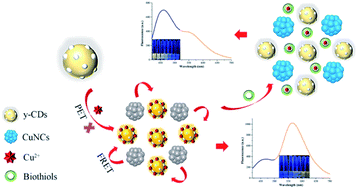Ratiometric fluorescence probe of Cu2+ and biothiols by using carbon dots and copper nanoclusters†
Abstract
A novel dual-emission ratiometric fluorescent probe based on N-doped yellow fluorescent carbon dots (y-CDs) and blue fluorescent copper nanoclusters (CuNCs) was established for quantitative determination of Cu2+ and biothiols. In this work, the Cu2+-(y-CDs) complexes formed by the chelation of y-CDs with Cu2+, showed an absorption peak at 430 nm that not only enhanced the fluorescence of y-CDs through inhibiting photoinduced electron transfer (PET) but also effectively quenched the fluorescence of CuNCs due to Förster resonance energy transfer (FRET). In addition, the chelation of y-CDs with Cu2+ could be inhibited by biothiols that prevented the fluorescence of y-CDs from being enhanced and the fluorescence of CuNCs from being quenched. On account of the changes of ratiometric signal, a dual-emission fluorescence probe for Cu2+ and biothiols determination was achieved. The proposed method exhibited high sensitivity for Cu2+ and biothiols in the ranges of 0.5–100 μM and 0.8–50 μM and the limits of detection (LODs) of Cu2+, glutathione (GSH), cysteine (Cys) and homocysteine (Hcy) were 0.21 μM, 0.33 μM, 0.39 μM and 0.46 μM, respectively. Subsequently, the established strategy presented an application prospect for the detection of Cu2+ and biothiols in real samples.



 Please wait while we load your content...
Please wait while we load your content...